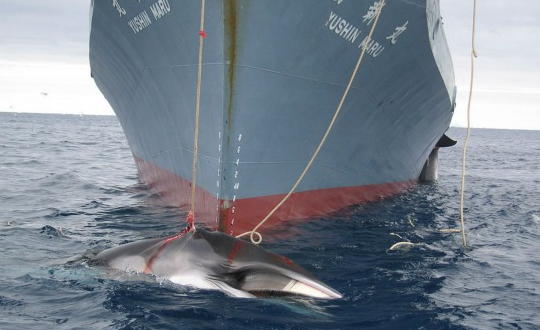Japan's new plan for research whaling calls for killing 333 minke whales annually |
Japan has unveiled its new whaling research program for the Antarctic. The plan sets a target of slaughtering 333 minke whales annually as part of a 12-year-long research effort "to achieve conservation of [Antarctic Marine Ecosystem] resources while pursuing their alleged sustainable utilization and to understand and predict the effects of factors such as climate change".
 The Japanese whaling vessel Yushin Maru harpoons a whale. |
| Tweet |
The New Scientific Whale Research Program in the Antarctic Ocean replaces a similar project halted by the International Court of Justice (ICJ) in The Hague last March. That program, known as JARPA II, called for taking 850 minkes, 50 humpbacks, and 50 fin whales annually, though in recent years actual captures fell far below those targets because of interference by antiwhaling activists.
Conservation organizations immediately denounced the new plan. "Even though the new research plan announced today emphasizes the addition of non-lethal research, the previous survey's main objective of continuing whaling is not changed in any way," Junichi Sato, executive director of Greenpeace Japan wrote in a Japanese press release. "It is widely understood that this project uses large amounts of tax monies to protect the interests of the whaling industry."
The draft, which will now be presented to the Scientific Committee of the International Whaling Commission (IWC), is open to revision. "We are willing to improve the research plan in response to comments and suggestions," says Joji Morishita, Japan's commissioner to the IWC. Japan plans to resume research whaling during the 2015 to 2016 austral summer. The IWC has no legal authority to block the resumption of research whaling, and it's not clear if any country will take the matter back to the ICJ. International criticism may be the only option to stop research whaling, Sato told ScienceInsider.
Critics have long claimed that Japan's research program is a fig leaf to sidestep the IWC's 1982 moratorium on commercial whaling. The 1946 International Convention for the Regulation of Whaling allows taking whales for research purposes and allows the meat to be sold on the market; Japan uses the proceeds to defray research expenses. Whale meat dishes are widely available at specialty restaurants, in supermarkets, and online, and some Japanese consider it a delicacy. But consumption has declined in recent years and much of the annual catch ends up in storage.
Australia took the matter to the ICJ in 2010. In its 31 March decision, the court found that, among other shortcomings, the target sample size of the Japanese program was not scientifically justified, nonlethal means of doing the research were not sufficiently considered, and there was little peer-reviewed science. "The evidence does not establish that the program's design and implementation are reasonable in relation to achieving its stated objectives," said the court, which ordered Japan to immediately halt whaling operations under the Antarctic research program. The ruling did not apply to a similar effort in the North Pacific nor to small-scale coastal whaling.
Although widely reported as a knockout punch, the ruling was more of a slap on the wrist. The ICJ's ruling acknowledged that research whaling is permissible under the IWC convention and that lethal methods are not specifically proscribed. "It is to be expected that Japan will take account of the reasoning and conclusions contained in this judgment as it evaluates the possibility of granting any future permits" for research whaling, the ruling stated.
The 100-page draft plan released today addresses the court's findings one by one and explains why collecting accurate data on the ages of minke whales requires killing them. A 14-page appendix then details why 333 of the animals are needed. "We did our best" to respond to the court's concerns, Morishita says.
Greenpeace's Sato says the justifications for lethal methods and target samples sizes "are just like what they were for JARPA I," Japan's first research whaling effort, which ended in 2005. "I don't think this plan sufficiently reflects the findings of the international court."
Timothy Stephens, an environmental lawyer at the University of Sydney, doesn't think the Australian government will take the case back to court. The current Liberal Party administration of Prime Minister Tony Abbott "is not especially keen to push the whaling question," he says. Whether other countries might step in is unclear.
Japan's whaling proponents say there are no good scientific reasons for a blanket ban on commercial whaling. Morishita says he personally would favor a compromise that would allow limited commercial whaling while strengthening conservation efforts. He and others argue that minke whales are not threatened and could be sustainably harvested. The International Union for Conservation of Nature Red List of Threatened Species has the common minke whale categorized as of "least concern" and the Antarctic minke as "data deficient," noting: "Although there is no accepted estimate of current abundance, the population size is clearly in the hundreds of thousands." The opposition to whaling is not based on conservation objectives but rather on a philosophical position against taking any marine mammals, Morishita says.
Posted in Asia/Pacific, Plants & Animals, Policy Whales
By Dennis Normile - November 18, 2014
Copyright © 2014 American Association for the Advancement of Science. All Rights Reserved.